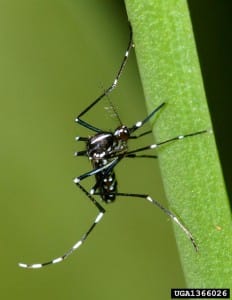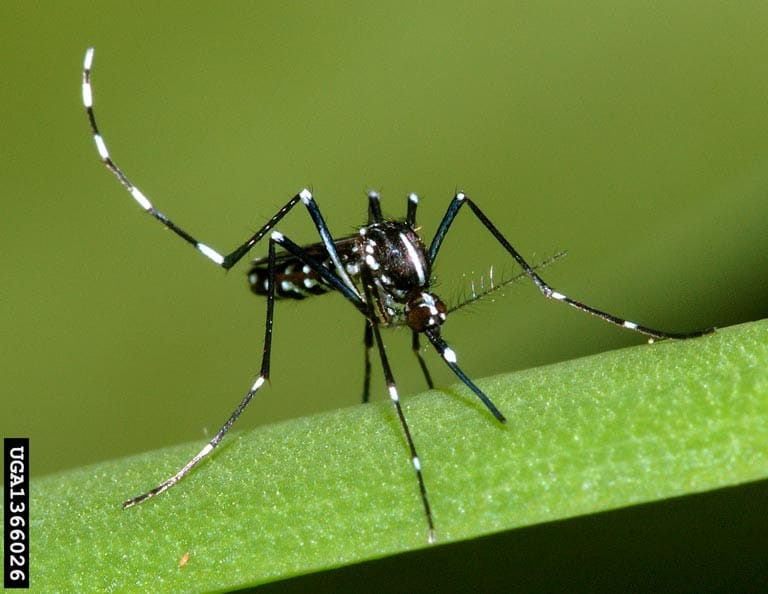
Elmer Gray, UGA Entomologist
Adult mosquito control is a growing business. However, depending on the local environment, success can vary. The first technique in most mosquito control programs is eliminating or treating the water where mosquito larvae develop (larviciding). In addition, some homeowners are looking for help to kill adult mosquitoes (adulticiding).
As with any pest management program, identifying the pest is extremely important. Knowing the particular species of mosquito you are targeting will help operators locate the larval habitat and devise the most efficient plan of attack.
In support of this type work, Dr. Rosmarie Kelly from the GA Department of Public Health has offered mosquito identification classes in the past and plans to do so in 2014 if the budget permits. Watch the Pest Control Alerts training calendar for information on these and other trainings. Dr. Kelly may be able to help with identifying small numbers of mosquitoes if you cannot attend these classes. Also see the information on mosquito identification in this article.
By identifying the pest species and targeting the larval habitat first, companies can sell their program as operating in an Integrated Pest Management (IPM) manner. This is because these pesticide applicators target the pest in the most efficient manner even if that is by adulticiding. In some areas of Georgia, there can be vast acreages of low lying, wet areas that create excellent larval mosquito habitat. In this case, the best operators can do on a small scale is to larvicide the closest larval habitats where mosquito larvae are present and then adulticide around the area you are trying to protect.
ULV Application
When trying to suppress the adult mosquitoes prior to an event, some type of Ultra Low Volume (ULV) sprayer can be very helpful. There are a variety of sizes available, from those that fit in the back of a pickup truck, which can be used for whole communities to handheld units for much smaller areas. There are also some that fit on 4-wheelers, which can be handy for a smaller operation.
Permethrin is still a good choice for ULV applications, but the whole range of products available is listed in the Commercial Pest Management Handbook. As with all pesticides, follow the label closely.
With small scale adulticiding, suppression of the pest population is usually temporary. Any of the products when used properly will kill the adult mosquitoes that come in contact with the aerosol produced by the ULV machines. However if there are large areas of larval habitat surrounding the site, more mosquitoes are coming. When significant mosquito populations are present, a Wednesday and Friday evening application may be needed to provide relief for a weekend event. From an environmental, ethical and economical standpoint; it is important to only apply pesticides when significant mosquito populations are present.
One technique that has been used for a long time to monitor adult mosquito populations is the “landing rate count”. The technique consists of counting the number of mosquitoes that land on a person in a given amount of time. Consistency is extremely important with this technique. It is best if one person conducts the evaluation at a specified site, at a similar time of day, wearing similar clothing. Dark blue coveralls (most biting flies are attracted to dark colors) can be used to standardize clothing and reduce the actual number of bites received. A typically protocol could involve an individual standing in a semi-protected area (out of the wind) for one minute, and then counting the number of mosquitoes landing on the front half of the body. Landing rate data is important when documenting the need for adulticide applications.
Timing ULV Applications
ULV adulticiding should not be conducted during the heat of the day, when the insecticide will be carried away from the mosquito habitats by heat radiating from the ground. Adulticiding should be conducted when there are temperature inversion conditions that hold the aerosol of insecticide droplets close to the ground where the mosquitoes are active. This is usually in the early morning and later in the evening when the ground cools and the air close to the ground is cooler than the air higher up.
Barrier Sprays
Another technique that has proven effective for adult mosquito suppression is barrier sprays. Applicators apply a uniform spray to vegetation, taking care to cover the undersides of the leaves where the mosquitoes rest during the heat of the day. The adult mosquitoes are killed when they contact the residual chemical. Any type of pressurized sprayer can be used. The active ingredient of choice for barrier sprays is bifenthrin, but permethrin and the other pyrethroids are effective as well.
Barrier sprays are particularly effective against the Asian tiger mosquito, Aedes albopictus, which is our most common mosquito pest throughout most of Georgia. (In coastal areas, the salt marsh mosquito is predominant). The Asian Tiger mosquito develops in containers during the heat of the summer and is described as a daytime biter. Consequently, it is difficult to use ULV applications for this pest, because the Asian tiger mosquitoes are not active after dusk when conditions are best for ULV operations. As a result, public education to encourage people to eliminate containers and standing water around their homes is extremely important, but realize that compliance is a concern.
West Nile Virus
The presence of West Nile Virus (WNV) has created more interest in mosquito control. Now there is a focus on the Southern House mosquito, Culex quinquefasciatus, which is the primary vector of WNV in the southeast. This species prefers to develop in nutrient rich waters, like waste lagoons and catch basins. When it gets dry, the water stands in the catch basins and storm drains and this species proliferates. This leads to confusion about wet and dry conditions. When the weather is wet, all the other mosquitoes do well. When it is dry and water stagnates in the storm drain system, the Southern House mosquito thrives and there is an increased risk of WNV transmission.
There has been a whole series of products developed for treating water in storm drains and catch basins, including Bacillus thuringiensis subsp. israelensis (Bti) and Bacillus sphaericus based products and a variety of methoprene formulations.
Pesticide Applicator Licensing for Mosquito Control
A couple years ago Georgia created a mosquito control category for certified pesticide applicators, Category 41 – Commercial Mosquito Control. Applicators that were already treating mosquitoes before this time under Category 31 (Public Health) are allowed to continue treating mosquitoes using their current license. New applicators should obtain a Category 41 license.
The training manual for Category 41 is very helpful, since it was created to be used as a resource for smaller operators. Order the Mosquito Pesticide Applicator study materials (Mosquito Biology, Surveillance and Control) at – http://www.caes.uga.edu/publications/for_sale.cfm
If an applicator wants to obtain a Category 41 license, there is also a video to help as they study the manual and prepare for the exam. Find the video at this website.
If any commercial companies are conducting large-scale mosquito control programs, they may need to file a Notice of Intent (NOI) for an NPDES permit. The website for the Georgia Mosquito Control Association (gamosquito.org) has information on permitting and is loaded with other relevant information.
(The Alerts editor wants to say ‘Thank you!’ to Dr. Rosemarie Kelly who reviewed and contributed to this article.)
